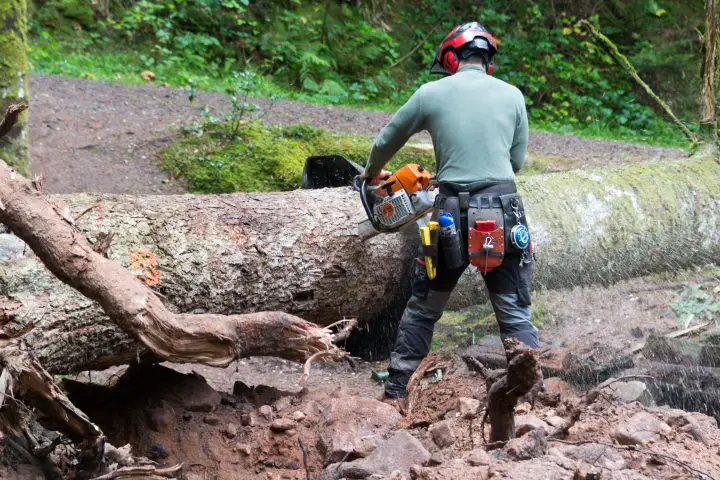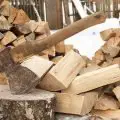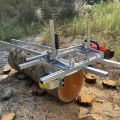When it comes to chainsaw safety, protecting your legs is a top priority. Chainsaws are powerful tools that can cause serious injuries if not handled with care. That’s why it’s important to invest in protective gear that can reduce the risk of accidents.
Two popular options for chainsaw safety gear are leather chainsaw chaps and Kevlar chainsaw pants. In this article, we’ll compare leather chainsaw chaps vs kevlar chainsaw pants and help you choose the right one for your needs.

Table of Contents
- Overview of Leather Chainsaw Chaps
- Overview of Kevlar Chainsaw Pants
- Leather Chainsaw Chaps vs Kevlar Chainsaw Pants: Which Is Better?
- Tips for Choosing Chainsaw Safety Gear
- Conclusion
- FAQs (Frequently Asked Questions
Overview of Leather Chainsaw Chaps
Leather chainsaw chaps are made from heavy-duty leather that is designed to protect your legs from cuts and scratches. These chaps are worn over your regular work pants and are secured with straps around your waist and legs. They have layers of material that are designed to stop the chainsaw from cutting through the leather and into your skin.
Leather chainsaw chaps are durable and can withstand a lot of wear and tear. They’re also easy to clean and maintain, which makes them a popular choice for many chainsaw users. However, they do have some drawbacks that you should be aware of.
One of the biggest disadvantages of leather chainsaw chaps is that they can be heavy and uncomfortable to wear for long periods of time. The straps can also be restrictive, which can make it difficult to move around freely.
Additionally, leather chaps don’t provide protection for the front of your legs, which means that you could still be at risk of injury if the chainsaw comes into contact with the front of your legs.
Overview of Kevlar Chainsaw Pants
Kevlar chainsaw pants are made from a type of synthetic material that is designed to protect against cuts and abrasions. They’re similar in design to regular work pants, but they have layers of Kevlar fabric that are designed to stop the chainsaw from cutting through the material and into your skin.
They’re often more lightweight and flexible than leather chaps, which can make them more comfortable to wear for longer periods of time.
Kevlar chainsaw pants offer full leg protection, which means that you’re less likely to sustain serious injuries if the chainsaw comes into contact with any part of your legs. They’re also more versatile than leather chaps, as they can be worn as standalone pants without the need for additional clothing underneath.
However, Kevlar chainsaw pants also have some disadvantages. They can be more expensive than leather chaps, which can be a consideration for some users. Additionally, they can be more difficult to clean and maintain than leather chaps, which can be a drawback for those who want gear that is easy to care for.
Leather Chainsaw Chaps vs Kevlar Chainsaw Pants: Which Is Better?
When deciding between leather chainsaw chaps and Kevlar chainsaw pants, there are a few factors to consider. Here are some of the key differences between the two types of protective gear:
Protection
Both leather chaps and Kevlar pants offer protection against chainsaw cuts and scratches. However, Kevlar pants offer full-leg protection, which makes them a safer option overall.
Comfort
Leather chaps can be heavy and uncomfortable to wear for long periods of time. Kevlar pants are often more lightweight and flexible, which can make them more comfortable to wear for extended periods.
Durability
Leather chaps are known for their durability and can withstand a lot of wear and tear. Kevlar pants are also durable, but they can be more prone to tearing if they come into contact with sharp objects.
Maintenance
Leather chaps are easy to clean and maintain, which makes them a popular choice for many users. Kevlar pants can be more difficult to clean and maintain, as they may require special care to maintain their protective properties.
Price
Leather chaps are often less expensive than Kevlar pants, which can be a consideration for those on a budget.
Overall, both leather chainsaw chaps and Kevlar chainsaw pants offer protection against chainsaw cuts and scratches. However, Kevlar pants offer full-leg protection and are often more comfortable to wear for longer periods of time.
Leather chaps are durable and easy to maintain, but they can be heavy and restrictive. Ultimately, the choice between the two types of protective gear will depend on your personal preferences and needs.
Tips for Choosing Chainsaw Safety Gear
In addition to choosing between leather chaps and Kevlar pants, there are a few other things to consider when selecting chainsaw safety gear. Here are some tips to keep in mind:
Fit
Make sure that your safety gear fits properly and is comfortable to wear. If your gear is too loose or too tight, it can be more difficult to move around freely and may not offer the protection you need.
Certification
Look for safety gear that meets or exceeds safety standards set by organizations such as the Occupational Safety and Health Administration (OSHA) or the American National Standards Institute (ANSI).
Visibility
Consider purchasing safety gear that is brightly colored or reflective. This can help increase your visibility and reduce the risk of accidents.
Maintenance
Make sure that you’re able to clean and maintain your safety gear properly. This can help extend the life of your gear and ensure that it continues to offer the protection you need.
On the topic of maintenance, learn every step you should be taking to ensure you’re using a chainsaw safely, by following these chainsaw maintenance checklist and chainsaw bar upkeep and maintenance guides!
Conclusion
Choosing the right chainsaw safety gear is important for reducing the risk of accidents and injuries. Leather chainsaw chaps and Kevlar chainsaw pants are both popular options for leg protection, but they have different advantages and disadvantages.
Consider your personal preferences and needs when choosing between the two types of gear, and make sure to also keep fit, certification, visibility, and maintenance in mind. With the right gear and precautions, you can safely use a chainsaw and get the job done.
Read our Chainsaw Pants vs Chaps guide for more leg safety tips.
FAQs (Frequently Asked Questions
Will Kevlar stop a chainsaw?
Kevlar can help stop a chainsaw, but it depends on the thickness of the Kevlar and the speed and force of the chainsaw blade. Kevlar is a very strong and durable material that is designed to resist cuts and punctures, but it is not completely chainsaw-proof. It is important to use Kevlar chainsaw pants or chaps that have multiple layers and are certified to meet safety standards.
How many layers of Kevlar are in chainsaw chaps?
The number of layers of Kevlar in chainsaw chaps can vary depending on the brand and model. Generally, Kevlar chainsaw chaps have multiple layers of Kevlar fabric and other protective materials, such as ballistic nylon. The layers work together to provide a barrier against the chainsaw blade and reduce the risk of injury.
Will chainsaw chaps stop a snake bite?
While chainsaw chaps are designed to resist cuts and punctures from chainsaws, they are not designed to protect against snake bites. Snake bites require specialized protective gear that is designed to prevent the venom from entering the body. If you are working in an area where snakes are present, it is important to wear protective gear specifically designed for snake bites.
Will leather stop a chainsaw?
Leather is not designed to stop a chainsaw and will not provide adequate protection against a chainsaw blade. Chainsaw blades can easily cut through leather, and wearing leather clothing while using a chainsaw can be dangerous. It is important to use safety gear specifically designed to resist cuts and punctures from chainsaws, such as Kevlar chainsaw chaps or pants.





